

Travel log Namibia - Second visit
Wednesday 01-11 (525 km)
At 05.30 hours we are up and packing the car. There is half an hour delay when we have a pleasant chat with an Australian couple. The woman was born on a white farm in Kitale, Kenya. At 07.00 we are in Livingstone looking for a petrol station that can put some more pressure in our rear air cushions. At the 4 th petrol station we are finally successful! The road to Sesheke is excellent and from Sesheke to Katima Mulilo there even is a new road, leading to a brand new bridge over the Zambezi. We are lucky: no more ferries! The border crossing is the fastest we have made so far in Africa and even the Zambian side, with the exception of the toilets, is well organised. At the Engen petrol station in Namibian Katima Mulilo we change money and have an early lunch. At 13.00 we sign the book at the military post and enter the Caprivi strip. For hours we drive along the Angolan border on the road that once used to be one of the most dangerous in southern Africa. Now, it is safe and peaceful and only for the most observant there are the occasional witnesses of more turbulent times: bullet riddled rusty truck and car cabins almost overgrown by the bush again. To our surprise and utter relief, the repaired front spring still functions and keeps the car straight. At 17.00 hours we finally reach the bridge over the Okavango River and sign out at the military control post in Divundu. A quarter of an hour later we arrive at the Popa Falls Resort, a camping run by the Namibian Wildlife Resorts (NWR). We hire a 4-bed cabin and treat ourselves to an expensive but mediocre dinner in the restaurant.
Thursday 02-11 (410 km)
We have breakfast on the balcony of our log cabin after which Paul services Wa Bashasha: topping up the engine oil, the oil in the gear boxes, the differential oil and the oil in the swivel pin housings. After that he greases the drive shafts. When he finally emerges from under the car, he is covered with a mixture of EP90, grease and fine red sand. After a shower and clean clothes, however, his foul “service mood” has disappeared.
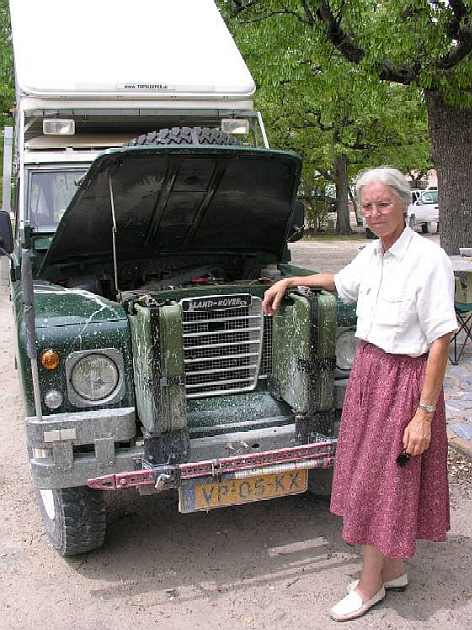
The first short rains give Wa Bashasha a well travelled “grey mud” look! I am looking well travelled too!
The road from Divundu to Rundu is perfect and in Rundu we find an operational ATM and have lunch. Shortly after 14.00 hours we head south again towards Roy's Camp , some 60 km from Grootfontein . Now and then we have some light showers, but it is getting noticeably cooler. At the veterinary control post – where they check the contents of our Engel fridge for the first time – we are acutely aware that we leave black Africa. From now on, there will be no more black villages along the road, no more markets and no shambas. Instead, there will be the fenced farms of the white Namibians and South Africans! At Roy's Camp they still know us and after inspecting the campsite – it is still very wet from the rains – we decide to camp but not to cook. The three-course dinner in the restaurant is the first delicious food I have in months. At night we sit around a wood fire with the staff and two other travellers and talk “Africa” and African cooking. When Paul is asked whether he knows why guinea fowl is always put in a pot together with a big stone, he is at loss. Roy's Camps' cook patiently explains. “After some hours of simmering on a low fire, you take out the guinea fowl and throw it away. The stone is ready to be served and eaten!”.
Friday 03-11 (230 km)
Early in the morning we drive to Grootfontein to shop and fill all petrol tanks. An hour later, we are on our way to Namutoni Camp in Etosha National Park . The trees are greener than in July, otherwise little has changed. We pitch tents under the same thorn trees where we stood with Barbara, Marc and their children and wonder what happened to the warthog that charged Paul after he chased him away from the potatoes of our neighbours. We cannot find this character and can but assume that he died of starch over-consumption whilst we were travelling Africa. Namutoni Camp is crowded with overlanders, but luckily they are at the far end of the camping site.
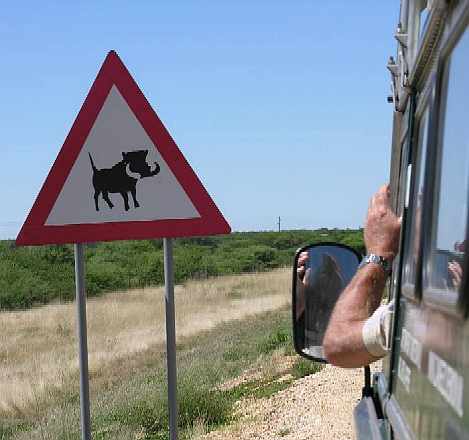
Another warthog. This one on the road from Grootfontein to Etosha.
Saturday 04-11 (95 km)
To Halali Camp is just under 100 km, and we take our time. Compared to July, Etosha is green and, therefore, the animals difficult to be seen. They do also not concentrate around a few water pools, where they are easy to detect, because water is everywhere this time of the year. Almost in sight of Halali Camp there is a brief moment of panic. A huge male Kudu jumps out of the bush.
When he realises that he is going to run into Wa Bashasha, he takes the heroic decision to jump over her bonnet. His bravery is rewarded with a narrow escape. We are all more than a little shaken and Eelko nor I had a camera ready in time. Halali is suffering from a major – and necessary – renovation. The place is dirty, there are stored building materials everywhere and we do not succeed finding some grass to pitch Eelko's tent.
Sunday 05-11 (220 km)
Early in the morning, via a number of detours, we drive to Etosha's Anderson Gate . Along the road, a springbok gives birth to a calve and we photograph the whole process. By 10.30 hours it is already getting hot and soon we are on the - deserted - tarmac road towards Outjo . Wa Bashasha is cruising 75 km an hour, providing us with ample opportunity to talk Africa again. Why are Namibia and South Africa so much more developed than the other countries we travelled through in the past couple of months? The first amazing observation is that most of the Africans we spoke to, do not (fully) realize how much they are lagging behind in the world's development. If you point out to them some of the most prominent ailments – corrupt politics, mass unemployment, the majority of people living below the poverty line, badly maintained infrastructure (roads and railways, among others) and lack of an industrial and service oriented competitive spirit (just to mention a few) – most of them immediately retaliate by blaming their predicament on colonialism and neo-colonialism. The legacy of which, apparently, is still holding development back. By and large, and by no means belittling the effects of colonialism, Paul finds this bullshit. Most African countries have been independent for over 40 years, countless billions have been spent on education and other development prerequisites by the governments themselves and the international community and two full generations of Africans could, by now, have led Africa from the dales of misery to the summits of wellbeing. Or, to be more realistic, the path could, at least, have been climbed halfway. Instead, Africa lags in development, keeps moaning about the evil outside world, the bloody Europeans and the unfair deals they are getting from them and the rest of the world. Surprisingly enough, the two most advanced countries in Southern Africa, Namibia and South Africa, still happen to have sizeable European minorities. Could there be a link, is it coincidence or is the sheer idea just a blatant racial bias? Africa, according to Paul, is on holiday whilst the rest of the world is fighting to gain a place in a globalising world. When I suggest that Paul changes the name of his new book from “Clouds are the Sign of Rain” to “Africa is on Holiday”, he seriously considers this possibility. Around 16.00 hours the traffic density increases and all of a sudden we are in the outskirts of Outjo again.
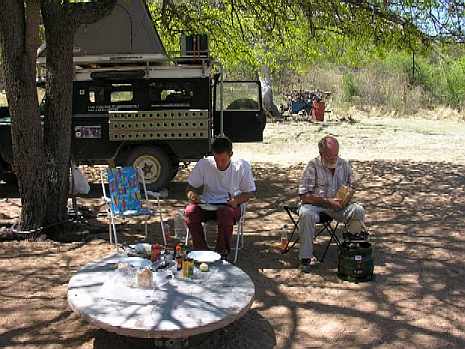
Oppi Klippe Campsite in Outjo
In the “Sunday Super Market” we buy some supplies and then head for Oppi Klippe Campsite. Mimmi and Jannie Linde recognize us immediately and later that night they join us at the campsite to hear more about our adventures in Africa. Before they leave, we agree that we will visit Jannie's father's farm in the early morning.
Monday 06-11 (325 km)
At 08.00 hours, we are at Lindehof - Jannie's father's farm - approximately 10 minutes down the road from Outjo to Otjiwarongo . Maize, alfalfa (both irrigated with sewage water from Outjo) and some cattle. Once again it strikes us how difficult it is to wrestle a living from the harsh conditions in Namibia and how modest many of the white farmers live. We have lunch in Okahanja and then proceed to Rehoboth . Here, we first pay a visit to the garage of Henry Beukes to arrange for the servicing of Wa Bashasha and then continue to drive on to Oanob Dam Resort. We are fed up with camping and hire a luxurious chalet: Simba. A well equipped kitchen, a sitting room, three bedrooms, two bathrooms and two balconies overlooking the lake!
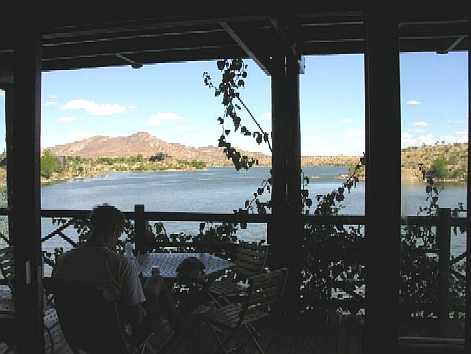
Sitting on one of Simba's balconies
Tuesday 07-11 (20 km)
A leisure day. We buy supplies at the Rehoboth Spar and clean up Wa Bashasha for her final run into the Cape.
Wednesday 08-11 (20 km)
Beukes' garage does a good job, but we sit there for 4 hours, before they have cleaned the air filter, changed the engine oil and checked on all the other oil levels. Finally, the car is cleaned with a high pressure hose and looks presentable again. At night I realize that we are finally out of the malaria zone and that we can finish our prophylactic treatment with Malarone. The Nivaquine and Paludrine we took daily for month did not really agree with our stomachs!
Thursday 09-11 (460 km)
Via Kalkrand , Mariental and Keetmanshoop we drive to Seeheim . All the villages we pass are basically outposts and still have the character of settler villages. In between the villages there is nothing but hundreds of kilometres of thorn bushes, mining pits and pebble deserts. No people, no animals, nothing. The cars are so few that the drivers greet each other and when we have lunch under a big thorn tree, the drivers of passing lorries blow their horn and wave.
The roads are excellent and only when we turn off towards Seeheim, we hit a gravel road again. The Seeheim Hotel and Campsite is a bit of a weird place. The original stone buildings probably stem from 1910 or thereabouts and later we hear from the present owner that the place was built by an officer of the German West Africa Schutztruppe. Later, in the 1920s, the place became a hotel and later still a farm house again. Now it is owned by a South African (farming) couple who build a kind a fairy castle on top of a small hill adjacent to the old buildings. The camping site is a dilapidated dusty corner but the ablution facilities are just adequate. The people, however, are very friendly and the diner they serve us is excellent indeed.
Friday 10-11 (315 km)
In the morning we decide to drive to Ai-Ais , Fish River Canyon, via the tarmac road. That way we will only suffer 75, instead of 200 km of dusty gravel roads. Soon after we leave Seeheim, it becomes extremely hot and soon we are all suffering to some extent. Once we turn off the tarmac road, some 70 km before Ai Ais, we begin our descend into the Fish River Canyon. Although the temperature has now risen to well over 40 Centigrade, we fully enjoy the magnificent scenery. Ai Ais Hot Springs Resort - wedged in between stone cliffs - is stifling hot and we decide to rent a two-bedroom backpacker cottage to have some comfort. At the reception we discover that, apart from the hot springs, there is nothing to do in Ai Ais. At this time of the year there is no access to the Canyon and there are no trails. In other words, to see the Canyon we are in completely the wrong place! Hobas is the place to go. We wonder why our Lonely Planet guide left us in the dark about the nature of Ai Ais. Our cottage turns out to be a wrong decision as well. The thick stone walls have stored the heat and at 23.00 hours it is till well over 30 Centigrade. When we open the windows to get some air in, there are plenty of mosquitoes and no mosquito netting.
Saturday 11-11 (395 km)
We all have a miserable night and are glad to leave the vastly overpriced Ai Ais resort in the early morning. If you visit Fish River Canyon, just forget about Ai Ais and go to Hobas . The gravel road to this NWR, winds through one of the most fantastic landscapes we have ever seen. The further we progress, the closer to the canyon we come. The beautiful scenery makes us forget the heat!
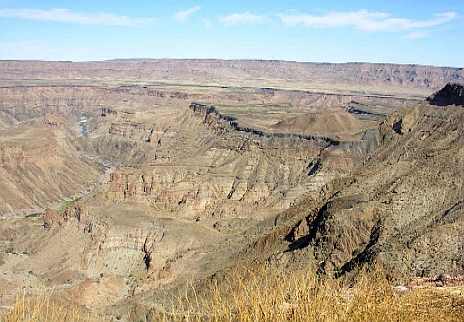
Fish River Canyon near Hobas
Unfortunately, the Fish River holds little water this time of the year and Paul's idea to spend a day fishing in Namibia is thwarted. Back in Hobas we inspect the campsite and conclude that there is much more shade and grass than in Ai Ais. The chalets look good value for money too. Nevertheless, we decide to try and reach Viooldrift in South Africa today and to camp somewhere along the Oranje River. Just before the border we stop at a motel next to the petrol station. The place looks sort of cosy and is shady. We order drinks and the waitress voluntarily brings us the menu. When, after a quarter of an hour, the waitress asks me what I would like to have for lunch I answer “a cheese sandwich”. “Sorry madam, we have run out of cheese”. When I ask what other possibilities there are, I get a somewhat surprising answer: “no other possibilities, madam, the kitchen is closed”. We finish our drinks and leave the premises hungry! The border crossing is uneventful and just after the barrier we turn right on the road along the Orange River. The road is dreadful and we cannot find the campsites. After 5 km we decide to return to the main road and to make it for Springbok. We arrive there just in time to buy ingredients for our dinner and to find the Springbok Municipal Campsite. Here, there are shady and grassy sites and the ablution facilities are excellent and spotlessly clean. The wind, however, is cold and soon, and for the first time in months, we sit in our cardigans shivering in front of a completely inadequate log fire. Even our roof tent is cold and it takes me some time to catch my sleep.
© 2005-2006 Paul and Meta Lapperre - Website by MvS
